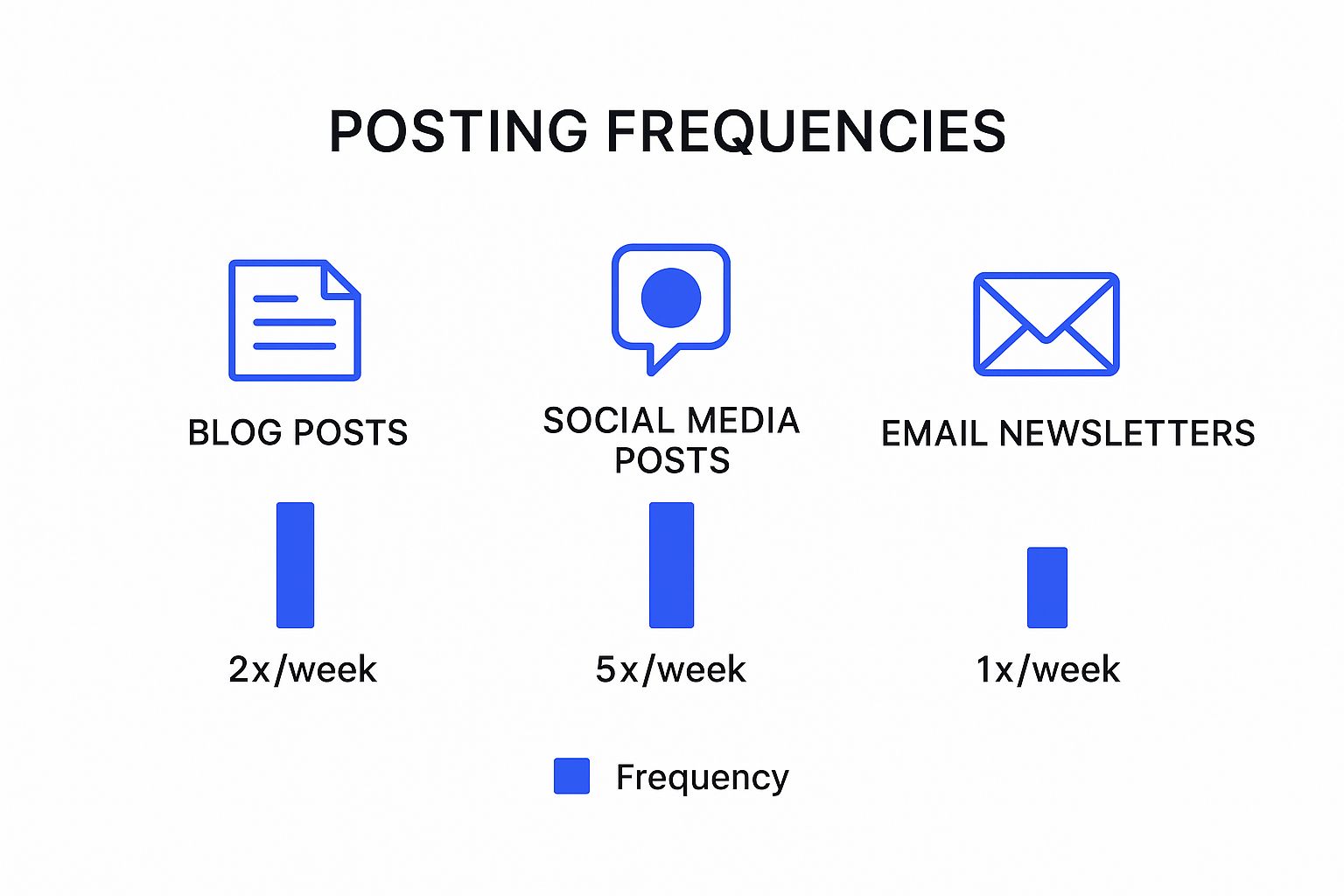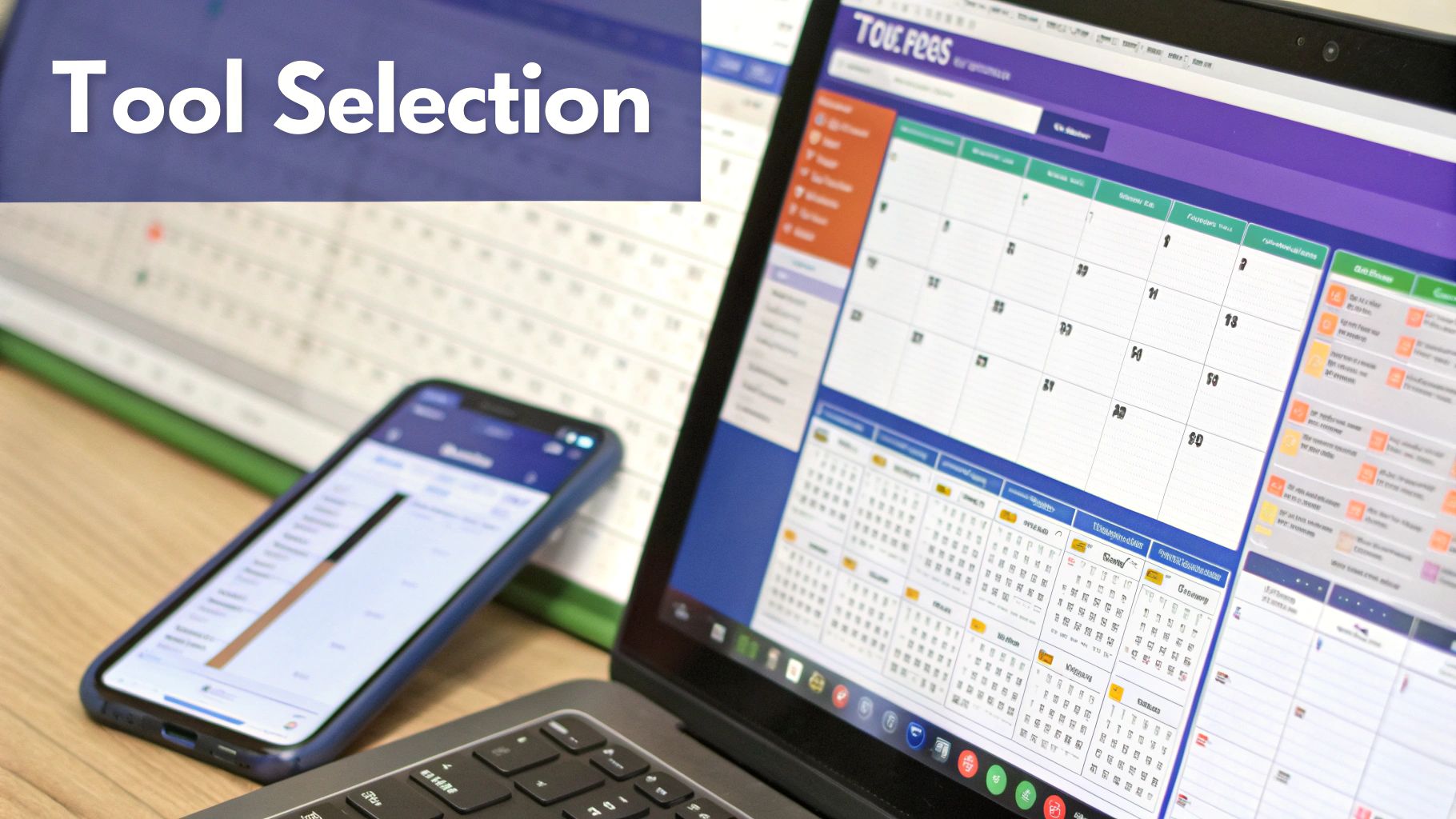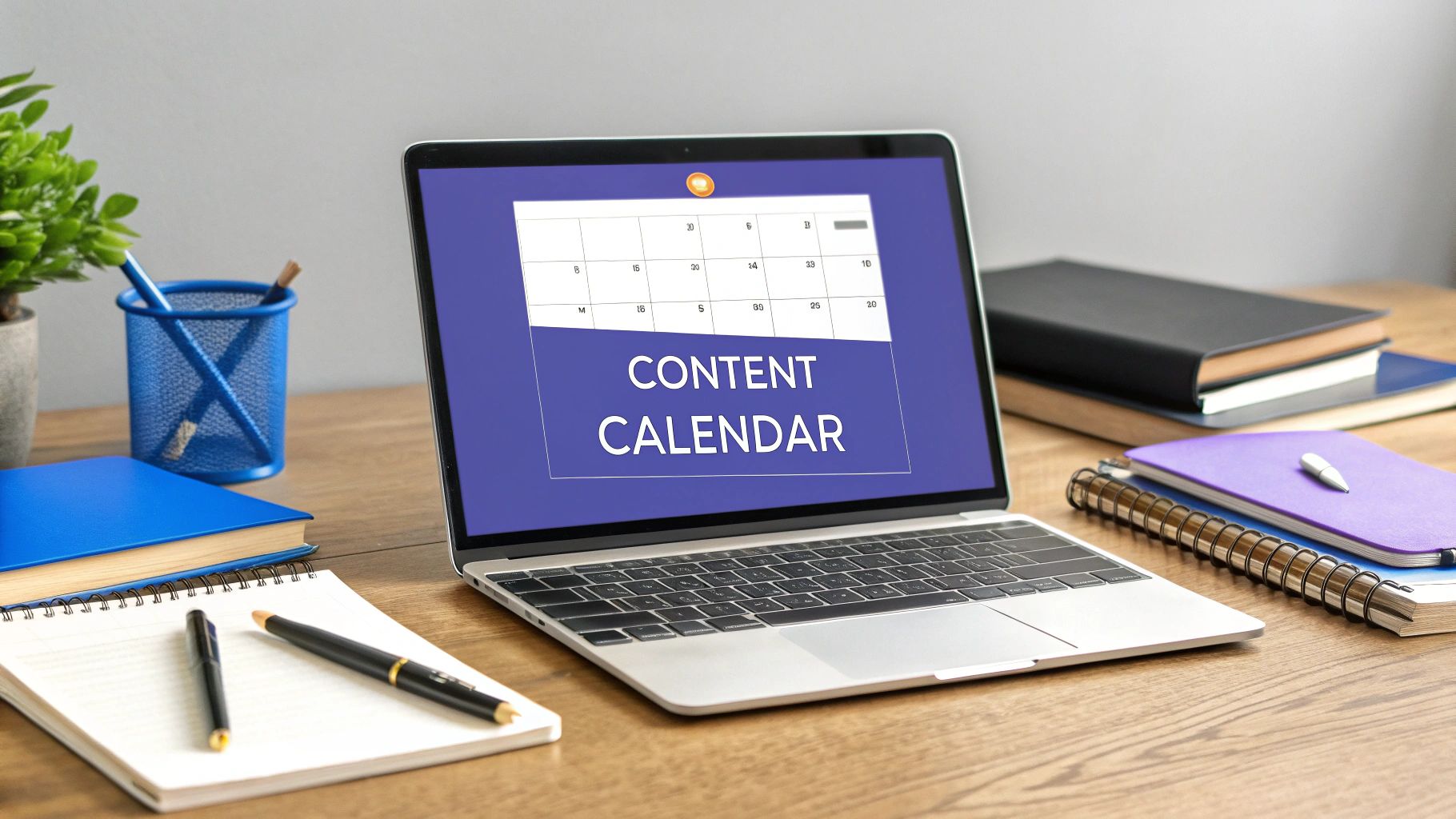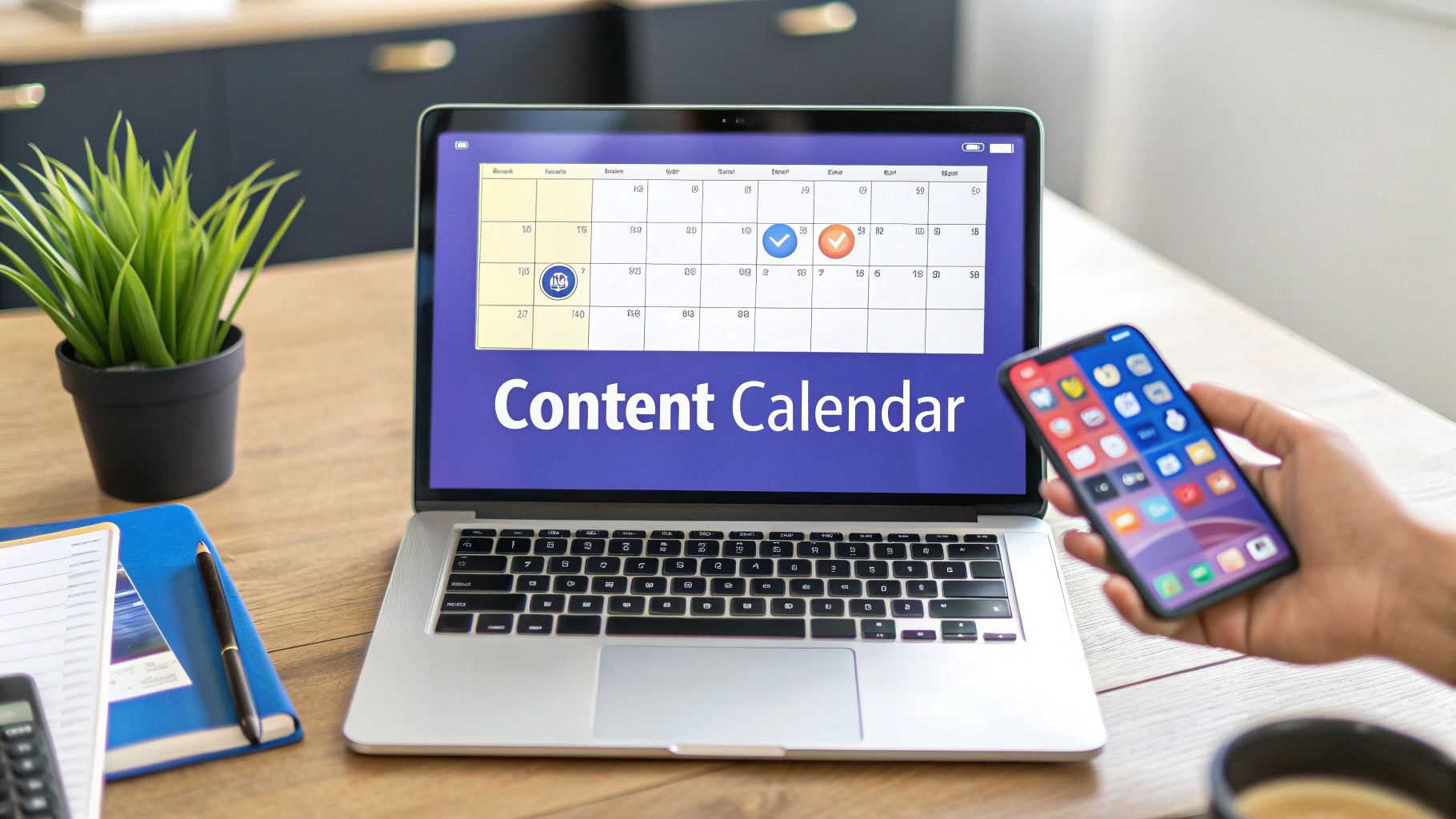At its core, creating a content calendar is about planning and scheduling what you’ll publish in the future. It’s the system that turns chaotic, last-minute marketing efforts into a predictable, strategic workflow by organizing topics, setting deadlines, and assigning tasks across all your channels.
The True Power of a Strategic Content Calendar

So many marketers get this wrong. They see a content calendar as nothing more than a glorified to-do list—a simple grid of dates and topics. But its real value comes when you treat it as the strategic heartbeat of your entire marketing operation. It’s what helps you evolve from reactive, frantic posting to proactive, goal-oriented content creation.
Think about it this way: it’s the difference between blindly throwing darts at a board and having a clear, calculated plan to hit the bullseye every single time. Without this central document, marketing teams often end up working in silos. This leads to mixed messages, wasted effort, and that all-too-familiar scramble to find something—anything—to post.
A smart approach to content calendar creation ends this chaos for good. Your calendar becomes the single source of truth that aligns everyone, from writers and designers to social media managers and SEO specialists.
From Simple Schedule to Strategic Powerhouse
So, how do you elevate a basic schedule into a genuine strategic asset? It’s all about building a framework that not only organizes your tasks but also ties every single piece of content back to a specific business goal. This shift in thinking is absolutely critical for long-term success.
This transformation happens when you start including components that provide real clarity and direction. Instead of a vague entry like "Blog Post for Friday," a strategic calendar forces you to answer the important questions:
- Why are we creating this? (Is it to generate leads, build brand awareness, or educate our existing customers?)
- Who is this for? (Are we targeting a specific audience segment with a well-defined problem?)
- How will we know if it worked? (What are we tracking—clicks, conversions, engagement rates?)
A strategic content calendar is more than a management tool; it’s a commitment to intentionality. It ensures that every asset you produce has a purpose, a place in your customer's journey, and a clear path to delivering results.
This structured approach also does wonders for team morale and efficiency. When your team can see the upcoming pipeline clearly, they can manage their time better, collaborate without friction, and produce higher-quality work—all without the constant stress of vague, looming deadlines.
The Key Components of a High-Impact Calendar
To build this powerhouse of a calendar, you need to incorporate a few key elements. We know from experience and recent studies that using a content calendar boosts organization and consistency, which directly helps grow an online community and hit long-term marketing goals. This system ensures your brand voice stays unified across every platform, improving both internal teamwork and external messaging. You can dig deeper into how a structured plan improves social media by checking out these insights on better social content.
Here are the essential components that will turn your simple spreadsheet into a high-performance strategic tool.
From Schedule to Strategy: Key Calendar Components
A truly effective calendar is more than just a list of dates. It's a comprehensive dashboard that connects your daily tasks to your big-picture goals. The table below outlines the key components that transform a basic schedule into a powerful strategic asset, giving your team the clarity they need to create content that moves the needle.
| Component | Strategic Purpose | Example |
|---|---|---|
| Content Pillars | Groups content into core themes that reinforce brand expertise and align with audience interests. | A fitness brand might have pillars like "Nutrition," "Workout Guides," and "Mental Wellness." |
| Target Keywords | Ensures content is optimized for search engines, driving organic traffic and visibility. | A blog post about home workouts might target "at-home HIIT workout for beginners." |
| Status Tracking | Provides a real-time view of the content pipeline, from ideation to publication. | Statuses could include "Idea," "Drafting," "In Review," "Approved," and "Published." |
| Performance Metrics | Connects content efforts to business goals by tracking key performance indicators (KPIs). | Tracking metrics like "Page Views," "Conversion Rate," or "Social Shares" for each piece. |
By weaving these elements into your calendar, you create a dynamic command center for your entire content strategy. It provides the focus and direction needed to not just fill your schedule, but to fill it with content that truly matters. Getting this foundation right is the first major step toward mastering your content workflow.
Building Your Calendar on a Solid Foundation
 It’s tempting to jump right in and start plugging dates into a calendar. I've been there. But trust me, that’s a surefire way to create content that just doesn't land. Before you even think about scheduling a single post, you need to build a rock-solid strategic foundation. This groundwork is what separates a calendar that just fills empty space from one that actually drives business growth.
It’s tempting to jump right in and start plugging dates into a calendar. I've been there. But trust me, that’s a surefire way to create content that just doesn't land. Before you even think about scheduling a single post, you need to build a rock-solid strategic foundation. This groundwork is what separates a calendar that just fills empty space from one that actually drives business growth.
Taking the time to lay this foundation ensures every single piece of content you plan has a clear purpose. You’ll move from a “create content for the sake of it” mindset to producing targeted assets designed to hit specific, measurable goals. The very first step? Getting crystal clear on what you want your content to do.
Define Your Marketing Objectives
Your content needs a job. Seriously. Is its purpose to attract new eyeballs, nurture potential customers, or keep your existing ones happy? Without clear goals, you’re just making noise. Setting these objectives has to be the absolute first step in your content calendar creation process.
Your goals will dictate everything that comes next—the topics you select, the formats you create, and the platforms you focus on.
A few common content marketing goals I see all the time include:
- Generating new leads for the sales team.
- Increasing organic website traffic by a specific percentage.
- Growing social media followers and engagement on key platforms.
- Boosting brand awareness in a new market.
These goals can't be fuzzy. Use the SMART framework (Specific, Measurable, Achievable, Relevant, Time-bound) to give them real teeth. For instance, instead of a vague goal like "get more leads," a much better one is, "Increase marketing qualified leads from our blog by 15% in the next quarter."
With a clear goal in mind, every single person involved in the content process knows exactly what success looks like. This clarity prevents wasted effort and ensures every project on your calendar is pushing toward a meaningful result.
Once you know what you're aiming for, the next logical question is who you're trying to reach.
Understand Your Target Audience Deeply
You simply can't create content that resonates if you don't know who you’re talking to. A deep, almost obsessive understanding of your audience is the true bedrock of any successful content strategy. This goes way beyond basic demographics like age and location.
To create content that truly hits home, you have to dig into your audience's psychographics. That means understanding their challenges, their aspirations, and what keeps them up at night.
Ask yourself these critical questions to build out a robust audience persona:
- What are their biggest pain points? What problems are they actively trying to solve that your business can help with?
- Where do they spend their time online? Are they professionals on LinkedIn, scrolling through Instagram, or asking detailed questions on Reddit?
- What content formats do they prefer? Do they love in-depth blog posts, quick-hitting videos, or detailed case studies?
A pro tip: talk to your customer-facing teams, like sales and support. They are an absolute goldmine for this kind of information. They have firsthand knowledge of the real questions and objections that pop up every single day. Use that insight to build content that provides genuine solutions.
Conduct a Thorough Content Audit
Finally, you need to know what you’re already working with. A content audit is just a systematic review of all your existing content to see what’s working, what’s flopping, and where you have gaps. This simple process stops you from reinventing the wheel and helps you spot some easy wins.
Dive into your analytics. Pinpoint your top-performing blog posts, your most-shared social content, and your highest-converting videos. What do they all have in common? Are there specific topics or formats that consistently deliver?
This analysis helps you find patterns. For example, you might discover that all your "how-to" guides pull in significant organic traffic, while your company news updates get almost no engagement. That data is pure gold for planning future content. An audit will also shine a light on opportunities to update and repurpose evergreen content, giving it a fresh coat of paint and maximizing its ROI. By building on this solid foundation, your content calendar becomes a powerful tool for intentional, results-driven marketing.
Alright, you've got your strategy mapped out. Now for the fun part: building the actual home for your content operation. This isn't just about creating a schedule; it's about designing a practical, user-friendly template that becomes the single source of truth for your entire team.
Whether you're a spreadsheet wizard or you live and breathe project management software, the bones of a great content calendar are always the same. A well-designed template is what connects your big-picture goals with the day-to-day work, making sure everyone knows what they’re doing and why.
Think of it like this: different channels need different levels of attention. You wouldn't post on your blog with the same frequency as you do on Twitter. This infographic gives a solid visual on how to think about posting cadence.

The real takeaway here is that your calendar needs to be flexible enough to handle this varied rhythm.
The Essential Fields for Your Template
A killer template is all about clarity. Every single column needs a purpose, giving your team critical info at a glance. To make your content calendar creation process truly effective, you’ll want to include these must-have fields:
- Publication Date: The non-negotiable D-day for when content goes live.
- Content Pillar/Theme: The core topic or category this piece belongs to. This keeps your strategy on track.
- Target Keyword: The main SEO keyword you're trying to rank for.
- Author/Owner: Who's responsible for getting this done? Put their name on it.
- Status: Where is this piece in the pipeline? Think: Ideation, Drafting, In Review, Approved, Published.
- Distribution Channels: Where will this content be shared? (e.g., Facebook, LinkedIn, Email Newsletter).
Having a dedicated spot for distribution channels is a game-changer. It forces you to think about promotion right from the start, not as an afterthought.
Your calendar template shouldn't just track what's being made; it should tell the story of each content piece from initial idea to final performance analysis. It’s a living document, not a static schedule.
Choosing the Right Tool for Your Team
Honestly, the "best" tool for your content calendar is the one your team will actually use day in and day out. You don’t need to drop a ton of cash on fancy software if a simple spreadsheet gets the job done. If you need some inspiration, it’s worth checking out some top content calendar template ideas to see what formats other teams are using successfully.
To help you decide, let's break down a few popular options and where they really shine.
Choosing the Right Tool for Your Content Calendar
Finding the right platform depends entirely on your team's size, workflow, and budget. A solo creator has vastly different needs than a large marketing department. This table compares some of the most common tools to help you find your perfect fit.
| Tool | Best For | Key Advantage | Potential Limitation |
|---|---|---|---|
| Google Sheets | Small teams, solo creators, or those starting out. | Highly customizable, free, and familiar to most users. | Lacks automated notifications and can become cluttered. |
| Trello / Asana | Growing teams that need clear workflow visualization. | Kanban boards, task assignments, and integrations. | Can have a learning curve and may require a paid plan for full features. |
| PostSyncer | Teams focused on social media who need an all-in-one solution. | Combines calendar planning with scheduling and analytics. | Primarily focused on social content management. |
As you can see, there's no one-size-fits-all answer. The key is to match the tool's strengths to your team's primary needs, whether that's collaborative workflow management or streamlined social media scheduling.
For a lot of us, a dedicated social media calendar is a massive part of the overall content puzzle. If that's you, check out our deep dive on how to create a social media calendar for more platform-specific tips.
Platform-Specific Considerations
While your main calendar gives you the 30,000-foot view, it’s smart to build in fields for platform-specific details, especially for channels that have their own quirks.
For example, planning your Instagram content with its own dedicated calendar is a proven way to boost engagement. When you map out post themes, specific hashtags, and captions in advance, you not only post more consistently but also save yourself a ton of last-minute stress. This approach turns a chaotic scramble into a well-oiled machine.
By building a template that’s both scalable and flexible, you’re creating an asset that will grow right alongside your team and strategy. It becomes the command center that keeps your entire content engine humming.
Finding High-Impact Content Ideas to Fill Your Calendar
An empty calendar is more than just a blank space—it's a missed opportunity. Once you've got your strategy and template locked down, the real fun begins: filling that schedule with ideas that actually get results. This isn't about just throwing spaghetti at the wall to see what sticks. It's about systematically digging into what your audience genuinely wants and needs.
The goal here is to build a solid backlog of topics that are not only relevant but also timed perfectly. It means leaving the guesswork behind and using real data to inform every single post you plan.
Mine Your Keyword Research for Gold
Your keyword research isn't just a list of terms for SEO; think of it as a direct line into your audience's brain. Every single search query is a question, a problem, or a need just waiting to be answered. By digging into these queries, you can uncover a treasure trove of content ideas that people are already searching for.
Start by looking for question-based keywords. Phrases that kick off with "how," "what," "why," or "where" are goldmines for educational content. For instance, a keyword like "how to fix a leaky faucet" is a crystal-clear signal that your audience is looking for a step-by-step guide.
Don't forget to pay attention to long-tail keywords. These longer, super-specific phrases often reveal exactly what a user is trying to solve and can inspire some incredibly targeted content. A search for "best budget-friendly running shoes for beginners" isn't just a keyword; it's a content idea handed to you on a silver platter.
Analyze Your Competitors' Successes
Why reinvent the wheel? Your competitors are already out there creating content. By seeing what's working for them, you can pinpoint proven topics and formats that you know will resonate with your shared audience. This isn't about copying—it's about smart, strategic analysis.
Use a few tools to identify their top-performing content—the articles, videos, and social posts that are pulling in the most traffic and engagement. Look for patterns:
- Recurring Topics: Are there specific themes they keep coming back to? That's a strong indicator of high audience interest.
- Popular Formats: Do their listicles always crush their case studies in terms of shares and comments? This can guide your own format choices.
- Content Gaps: What are they not talking about? This is your golden opportunity to step in and own a topic they've completely missed.
Your competitors' content library is a treasure map. By studying it, you can find the proven paths to success and discover the uncharted territories where you can plant your flag.
This kind of analysis gives you a serious competitive edge, helping you make much smarter decisions about where to focus your creative energy during the content calendar creation process.
Tap into Timeliness and Trends
Some of the most powerful content is timely. Planning your posts around seasons, holidays, and what's happening in the world connects your brand to the conversations your audience is already part of. This is where your calendar really proves its worth as a forward-planning tool.
A great content calendar is the backbone of any successful social media strategy. It's more than just a schedule; it’s a strategic map that aligns your message with cultural moments and customer interests. This approach lets you hit the big holidays that everyone is talking about while also tapping into niche holidays to connect with smaller, more passionate communities. You can dive deeper into how to plan for key dates on your social media calendar.
Use free tools like Google Trends to see what topics are gaining steam right now. If you can spot a trend early, you can create content that rides that wave of public interest, often bringing in a huge amount of traffic and visibility.
To make this whole process a lot smoother, you can start with a pre-built template. To get going fast, check out our guide for a free social media calendar template that helps you map out these timely opportunities. This ensures you always have a rich backlog of ideas that perfectly balance your evergreen strategy with what's happening in the moment.
Turning Your Calendar Into a Living Workflow

So, you've designed a beautiful calendar and packed it with brilliant ideas. Great. But a calendar sitting in a folder is just a pretty document—it's not doing any work. The real magic happens when you turn that static plan into the living, breathing heart of your daily operations.
This is where you bridge the gap between strategy and execution. It’s about creating a predictable rhythm that guides your team from that first spark of an idea all the way to a published, polished piece. No more "what happens next?" confusion.
From Initial Draft to Final Approval
A clear workflow is your best defense against content getting stuck in limbo. We’ve all been there—a draft gets written, sent for review, and then… crickets. A well-defined process creates a clear path for every project, making the whole system transparent and, more importantly, efficient. Think of it as your content assembly line.
Every piece of content should move through a few key stages, each with a clear owner. Here’s a flow that works for many of the most successful marketing teams I’ve seen:
- Ideation: The concept gets logged in the calendar, complete with its core goal and target audience.
- Drafting: The writer assigned to the piece gets to work on the first version.
- Internal Review: The draft is passed to an editor or a subject matter expert for their feedback and tweaks.
- Design & Visuals: Once the copy is locked in, the designers step in to create graphics, videos, or any other visual elements.
- Final Approval: The whole package—copy and visuals—gets a final thumbs-up from the key stakeholders.
- Scheduling: The finished piece is scheduled for publication using your CMS or a social media tool like PostSyncer.
This kind of structure is how you maintain momentum. It also helps you spot bottlenecks instantly. If drafts are constantly piling up in the review stage, you know exactly where you need to focus to get things moving again.
Fostering Effective Team Collaboration
Your calendar can be the ultimate collaboration hub, but only if your team actually uses it. The goal is to make it the single source of truth for your entire content operation. When everyone’s trained to check the calendar for updates, deadlines, and who’s responsible for what, you can finally kill those messy email chains and cut down on pointless meetings.
To get everyone on board, weave the calendar into your existing team routines. Pull it up during weekly check-ins to go over progress, celebrate what’s been published, and troubleshoot any roadblocks. This keeps the calendar front and center, reinforcing its role as your central communication tool.
A shared calendar doesn’t just organize tasks; it builds a culture of accountability and transparency. When everyone can see the entire pipeline, they understand how their individual contribution fits into the bigger picture.
If you’re just starting to build out a collaborative process, leaning on a pre-made structure can save a ton of time and headaches. You can learn more and grab a free editorial calendar template to get your team aligned and working together from day one.
Closing the Loop With Performance Tracking
Your work isn't done when you hit "publish." The final—and arguably most critical—step is closing the loop by tracking how your content performs. This is how your calendar evolves from a simple schedule into a smart engine for continuous improvement.
For every single item on your calendar, you should have a place to track its key performance indicators (KPIs). And these metrics shouldn't be random; they need to tie directly back to the original goals you set for that piece of content.
Example KPIs to Track:
- Blog post for lead generation? Track form submissions or demo requests it drives.
- Social campaign for brand awareness? Monitor reach, impressions, and new followers.
- Educational video? Look at watch time, click-through rates, and audience retention.
By consistently gathering this data, you start to see exactly what makes your audience tick. This feedback loop is pure gold. It lets you double down on what’s working, ditch what isn’t, and make your future content calendar creation efforts smarter every single time.
Common Content Calendar Questions Answered
Even with the best tools and a solid strategy, you’re bound to hit a few snags when building out your content calendar. It just happens. Getting answers to these common hurdles is often what separates a calendar that drives real results from one that just collects digital dust.
Let's dig into some of the most frequent questions I hear from teams trying to get their planning process right.
How Far in Advance Should I Plan My Content?
Ah, the classic question. The honest answer? It's all about balancing long-term vision with short-term agility. There's no magic number that works for everyone, but I've found a sweet spot that serves most teams well: plan one month in granular detail, but have a broader thematic outline for the entire quarter.
This hybrid approach really does give you the best of both worlds.
Your detailed one-month plan gives the team total clarity on what needs to get done now—no more confusion about deadlines or deliverables. Meanwhile, the three-month thematic overview keeps you aligned with bigger business goals. It lets you prep for major campaigns or seasonal pushes without that awful last-minute scramble. For massive events like a new product launch, you might even sketch things out six months ahead.
This structure gives you enough runway to be strategic, but keeps you nimble enough to jump on a trending topic or react to a sudden shift in the market.
What Is the Difference Between a Content and an Editorial Calendar?
People often use these terms interchangeably, but there's a subtle yet crucial difference. Think of it as the difference between a world map and a turn-by-turn GPS route.
An editorial calendar is your high-level map. It focuses on the big picture stuff—the major themes, core topics, and publication timelines for your key content initiatives. It's what a traditional magazine editor would use to answer, "What are the main stories we're telling this quarter?"
A content calendar, on the other hand, is the nitty-gritty operational tool. This is where the day-to-day execution lives, with all the specific details for every single piece of content. This includes things like:
- The exact copy for social media posts
- Who is assigned to write or design it
- Hard deadlines for drafts, reviews, and final approval
- Status updates (e.g., In Progress, In Review, Scheduled)
- Which specific channels it's being distributed on
Basically, your editorial calendar sets the strategy, and your content calendar manages the work. Many teams roll them into one master document, but knowing the two distinct functions is absolutely key to effective planning.
How Do I Get My Team to Actually Use the Calendar?
This is the million-dollar question, isn't it? You can build the most beautiful, color-coded, perfectly organized calendar in existence, but it's worthless if nobody on your team looks at it.
The secret to getting everyone on board is to make the calendar the undisputed single source of truth for all things content.
When the calendar becomes the easiest way for your team to get the information they need, adoption will follow naturally. It should be seen as a tool that reduces chaos, not another administrative task to check off.
How do you make that happen? Start by integrating it into your team’s existing habits. Bring it up on screen and use it as the agenda for your weekly content huddles. Assign clear ownership for every single task and stage so there’s never a question of who's supposed to do what.
And finally, make it dead simple to access and update. If it's buried three folders deep or requires some clunky login, people will just go back to asking questions in Slack. Make it central, make it useful, and make it a non-negotiable part of your routine.
How Often Should I Update or Be Flexible with My Calendar?
Your content calendar should be a living, breathing document—not a rigid plan that’s set in stone. Consistency is crucial, but you absolutely have to leave room for life to happen. Business priorities change, a competitor does something unexpected, or a new trend explodes overnight that you need to be a part of.
I always recommend scheduling a monthly review of your calendar. Use this time to check in on performance, see what’s actually connecting with your audience, and toss out any planned content that no longer feels relevant. If a topic is suddenly blowing up on social media, don't be afraid to reshuffle the schedule to get in on the conversation while it’s hot.
The goal is planned flexibility. The calendar provides the structure, but your team’s real-time insights and data should guide its evolution. That’s how you keep your content timely and impactful, turning a simple plan into a dynamic asset for your brand.
Ready to stop the chaotic scramble and build a content calendar that truly works? PostSyncer provides a centralized, AI-powered platform to plan, schedule, and analyze all your social content in one place. With drag-and-drop calendars and collaborative tools, you can turn your strategy into a seamless workflow. Start your free trial of PostSyncer today and see the difference a unified calendar makes.















